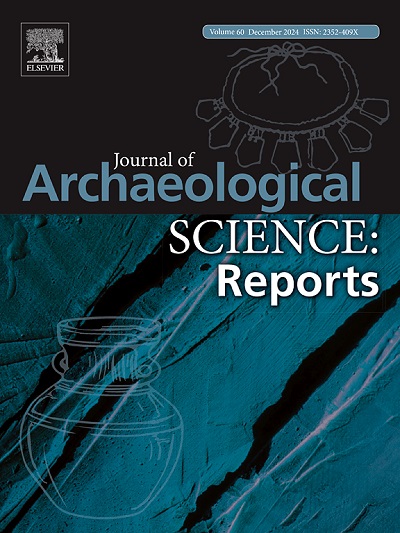Mössbauer巴伦西亚地区白云岩物源表征光谱:概念证明
IF 1.5
2区 历史学
0 ARCHAEOLOGY
引用次数: 0
摘要
蛇美岩的来源的确定对于理解新石器时代社区的贸易网络、流动模式和资源开发策略至关重要,因为这些岩石被广泛用于制造抛光工具,如斧头和锛。他们在农业实践和林地管理中的作用凸显了他们在伊比利亚半岛地中海地区新石器时代社会经济和文化转型中的重要性。通过追踪这些材料的起源和流通,我们可以对早期农业社会的相互作用、技术选择和适应策略获得有价值的见解。本研究评估了Mössbauer光谱(MoS)用于区分从不同露头收集的岩石的使用。MoS是一种强大的技术,可以提供晶体结构、磁态、价态和相组成的详细信息。本研究采用Fe57 MoS检测含铁相。在蛇辉岩样品中,确定了一系列铁相,包括磁铁矿、磁铁矿、赤铁矿。比较了几个不同露头样品的相组成,显示出差异。这可能允许使用MoS,结合其他技术,如XRF,岩石学,作为一种工具来确定蛇纹人工制品的来源。本文章由计算机程序翻译,如有差异,请以英文原文为准。

Mössbauer spectroscopy for dolerite provenance characterization in Valencia region: A proof of concept
The determination of the ophitic rock provenance is of key importance for understanding the trade networks, mobility patterns, and resource exploitation strategies of Neolithic communities, as these rocks were extensively used to produce polished tools such as axes and adzes. Their role in agricultural practices and woodland management highlights their significance in the socioeconomic and cultural transformations that characterized the Neolithic period in the Mediterranean area of the Iberian Peninsula. By tracing the origins and circulation of these materials, we can gain valuable insights into the interactions, technological choices, and adaptive strategies of early agrarian societies. This study evaluates the use of Mössbauer Spectroscopy (MoS) to distinguish rocks collected from different outcrops. MoS is a powerful technique which provides detailed information on the crystal structure, magnetic state, valence state and phase composition. In this study Fe57 MoS which detects the iron containing phases was used. In the ophitic samples a range of iron phases were identified including magnetite, maghemite, hematite. The phase composition of samples taken from several different outcrops were compared showing differences. This may allow the use of MoS, in combination with other techniques such as XRF, petrography, as a tool in the determination of ophitic artifact provenance.
求助全文
通过发布文献求助,成功后即可免费获取论文全文。
去求助
来源期刊

Journal of Archaeological Science-Reports
ARCHAEOLOGY-
CiteScore
3.10
自引率
12.50%
发文量
405
期刊介绍:
Journal of Archaeological Science: Reports is aimed at archaeologists and scientists engaged with the application of scientific techniques and methodologies to all areas of archaeology. The journal focuses on the results of the application of scientific methods to archaeological problems and debates. It will provide a forum for reviews and scientific debate of issues in scientific archaeology and their impact in the wider subject. Journal of Archaeological Science: Reports will publish papers of excellent archaeological science, with regional or wider interest. This will include case studies, reviews and short papers where an established scientific technique sheds light on archaeological questions and debates.
 求助内容:
求助内容: 应助结果提醒方式:
应助结果提醒方式:


